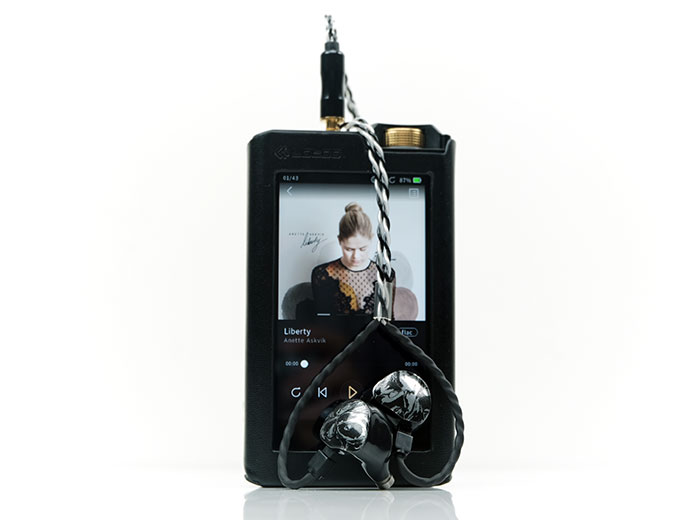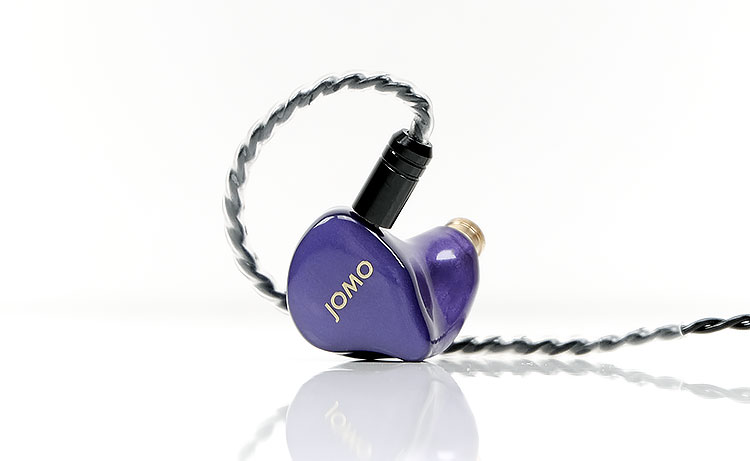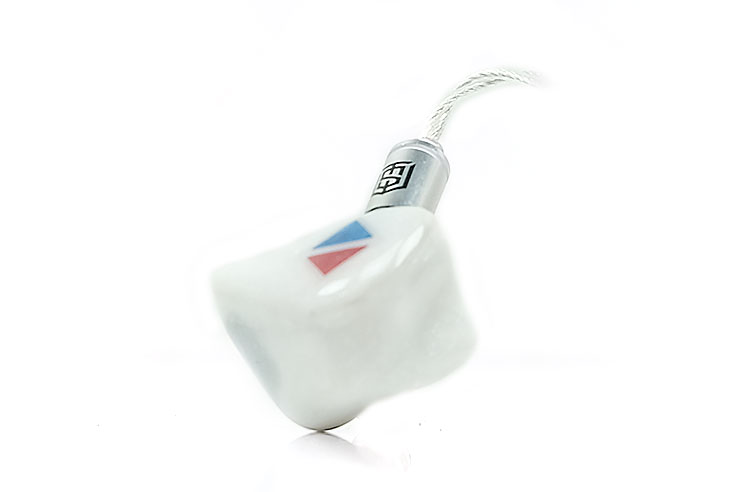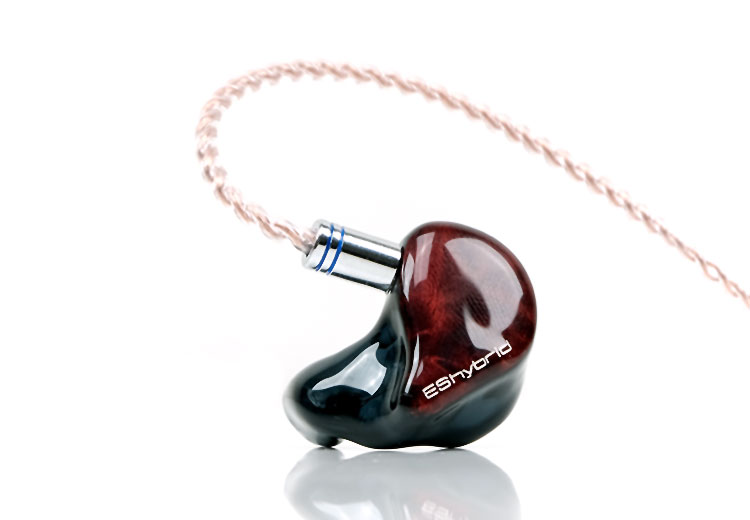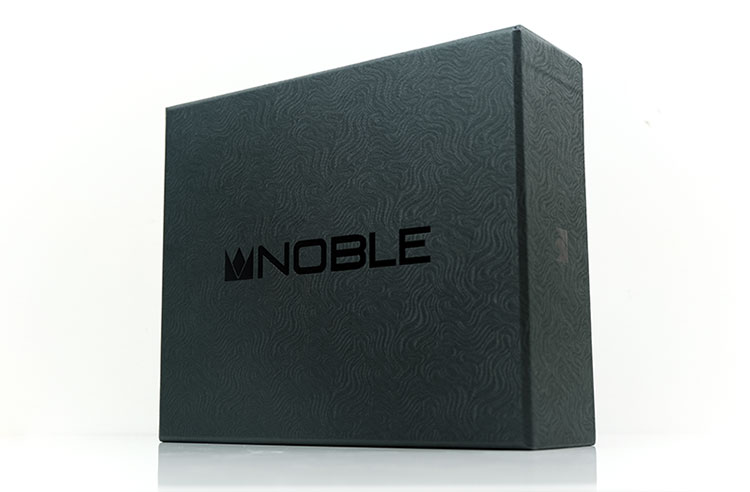Sound Impressions
Summary
The tuning on the Khan is probably the most nuanced of the e-stats infused monitors to date with regards to bass and mids performance. It is also the most striking when it comes to having a treble delivery that I find the closest to how a proper electrostatic headphone should perform.
The Khan has a gentle u-shaped frequency response and certainly not as full-bodied or as warm as the Trinity or Soranik’s new D.E.S. stats monitor. The presentation is just slightly to the natural sounding side as opposed to completely neutral. It is a tuning style that Noble applied successfully to the Katana. A little musical lilt if you will, only this time with a bit more body.
Dynamic Driver
The 10mm driver is also not quite as powerful as the very large 13mm graphene driver in the POLA. What you do get is a gentle sub-bass lift that holds to about 60Hz before dropping to around 500Hz and then it starts a rise again before peaking around 3k. Those additional 4 BA drivers also make a big difference to the level of resolution from the Khan’s midrange which is just excellent.
That elevated 1-3k presence brings an excellent level of vocal clarity but not so much that it is overly intimate. It is still relatively neutral sounding compared to the likes of the very forward and warmer sounding Soranik alternative.
It is also characterized by an abundance of quality treble with a sustained elevation from 5-9k before it starts to roll-off post 10k. This is not the kind of squeezed thin sounding peaky treble you get with some all-BA tunings. It is clear, highly articulate but with excellent body and detail. Match the Khan with the foams, stock cable and a warmish DAP such as the Sony 1Z and it is a divine performance.
Bass
What is extra special about the Khan low-end is the clarity from its 10mm dynamic driver right down to the sub-bass. Nothing muddy or soft about the layering here so it sounds tight, controlled and very nicely defined as a result.
The lack of mid-bass warmth does help with that drop starting well before the usual 100Hz marker. I will admit I do much prefer a low-end that draws more from its sub-bass power than mid-bass warmth. I tend to find lower pitched instrumental timbre to have a far better level of clarity and still retain an excellent fundamental when there is a slight sub-bass bias.
Granted some will find the timbre to veer more to the lean side as a result when creeping into the mids but for me, that additional level of clarity and instrumental separation that the Khan can provide without compromising on low-end power is worth it.
Mids
From 500Hz to 1k there is a rising response curve that helps the Khan presentation retain a fairly natural sounding timbre rather than worryingly lean. This is not a rich thick sound but rather more neutral than the Trinity and the Soranik. It is not as dipped as the POLA’s bigger dynamic drivers performance which tends to cast a little veil by comparison on some vocal pitching.
By comparison, the Khan vocal and midrange clarity is excellent, clean and very easy to pick up for detail, little spatial cues, and instrumental layering.
It is the kind of articulation that I loved with the Katana but it just sounds that bit more convincing on the Khan. Perhaps a combination of that dynamic driver creating a deeper soundstage combined with a more refined level of upper harmonic control with those stats drivers.
If there is anything to pick up on is that by comparison to some warmer signatures such as the Trinity the mids, particularly the upper mids, might seem a little harder edged and drier as a result. That will be more of a preference thing for me. It adds to the perception of clarity but others might find it less forgiving with percussion heavy bright recordings.
Treble
I love this treble and I am not really a huge treble fan. I have a decent collection of electrostatic headphones and one of the misconceptions is that stats treble is bright. That’s not really what it is about. For me, it is about the effortless delivery combined with an almost perfect balance between attack and decay and excellent body. Nothing sounds lean or uneven.
Noble have almost nailed it here, and out of the four stats monitors I have tested have come the closest to replicating that e-stats headphone treble quality with a superb airy performance. The FR is sustained from 5k to almost 9-10k so it is coherent sounding for a start. No weird dips robbing it of body and presence. This is not a lean sounding top-end.
Neither is it overly cranked up and compared to its sub-bass and mids elevation is remains nicely balanced and not so dominant as to rob the tone of much needed even-harmonic smoothness.
You could describe it as veering ever so slightly to the dry side with a shorter decay compared to the wetter Trinity top-end. The Khan is not as forgiving in that regard. Both do have the same level of detail, however, the Trinity is just so much more relaxed you tend to overlook some details now and then.
Matchability
Efficiency
The Khan is not as efficient as some standard hybrid likes the Campfire Audio Solaris or all-BA builds like the Andromeda or 64 Audio’s Trio. However, it is not that hard to drive either. Noble does not normally release any in-depth numbers regarding their IEM impedance and SPL numbers so it can be a bit of a guessing game.
What we do know is that it gets louder faster than the Trinity by some margin and also has a higher SPL than the POLA. We know the POLA is around 100dB and the Trinity is quite low at 96dB.
From our testing, we felt the Khan was closer to 105-110dB SPL. We are assuming that Noble is still tuning around 20-30Ω which has been much the case since we started reviewing their monitors a few years ago.
Noise
The Khan is a good performer for moderate noise floors or where some sources have been known to deliver a bit of hiss. You will hear performances with nice black backgrounds on the likes of the HiBy R6 Pro, iBasso’s DX200 (including Amp 8) and especially the Sony 1Z. The Khan’s impedance level is also high enough to countenances high output impedance DAPs such as the HiBy R6 (10Ω) and the cheaper Shanling M2s (4Ω).
Synergy
What all this means that you will not need significant power or current to drive the Khan or get it to suitably enjoyable volume levels. A quality DAP will work just fine. However, that is the caveat for me because I did not find all sources and amps to ideally match with the Khan’s tonal balance.
Lotoo PAW Gold Touch
For example, I was slightly less enamored with the clean, slightly treble-biased signature of the reference Lotoo PAW Gold Touch pairing. Treble lacked its normally delightful body and instrumental timbre sounded too lean for comfort.
It is by far my most resolving pairing though and if you avoid percussion heavy tracks and go for acoustics and more sparse arrangements then this pairing is delightful and precise.
Sony NW-WM1Z
However, it is the Sony NW-WM1Z pairing that took the bacon for me. The Khan immediately delivered a much nicer level of body, more low-end impact, and a smoother treble more in keeping with how I like to these stats monitors.
It might not be as quick and detailed as the Lotoo PAW Gold Touch but the better levels of warmth and a punchier low-end. Overall, a slightly more natural and enjoyable performance.
The Bit Opus#2
Using the same reasoning I would also plump for The Bit’s Opus#2 flagship DAP. It is not as weighty on the low-end as the Sony nor as resolving as the PAW Gold Touch. However, sounds really smooth and airy with the Khan. The treble performance and higher pitched instrumental timbre sounds wonderfully natural and effortless with this pairing.
Select Comparisons
Jomo Audio Trinity
SG$3,799.00
Technical
Much like the Khan, the Trinity is also a hybrid design with three different sets of drivers. Unlike the Trinity, the Khan is using a single 10mm piezoelectric super tweeter as opposed to the dual electrostatic drivers deployed by Jomo. For the lows, the Khan uses a 10mm dynamic driver and 4 BA for the mids and highs which mirrors the rest of the Trinity driver breakdown.
Build
Both are acrylic shell universal builds with very attractive but different design aesthetics. The Khan is a black shell with modern M3 composite twist on the traditional Mokume Gane metallurgy process for the faceplate.
The Trinity is all purple but with a slightly more aggressive custom universal shaping. The Khan has a longer nozzle so it penetrates slightly deeper but the body sort of hovers over the ridges of your ear whereas the Trinity sits a bit closer.
You get a far bigger selection of tips with the Khan including foams which is a type of tip I think should be in the Trinity bag. The whirlwinds are pretty good silicone tips though and better than the supplied silicone tips with the Khan.
Cable
Both are using a 4-wire SPC cable with similar properties for microphonics and memory retention. The Khan’s 3.5mm jack is straight with a gripper straight metal barrel compared to the smaller right-angled 3.5mm jack on the Trinity. I also like the black and white jacket on the Khan wire. It matches the black and white tone on the main build and very complimentary in aesthetics.
Performance
With the Trinity at 30Ω and a very inefficient 96dB SPL, you will find the Khan the more sensitive of the two by far. We believe the Khan is above the 100dB marker for SPL. Not that the Khan is hugely efficient in its own right, just that Trinity 96dB takes some juice to get going.
On the Aroma A10, we were on a modest low gain setting (9am) on the analog pot with the Khan. With the Trinity, we had to go a little higher on low-gain at 11am on the pot. Direct from the Sony 1Z the Trinity pushed its low gain volume all the way up to 105 with the Khan a good 25 steps lower around 80.
Tonality
Indeed, there are some tonal differences between these two flagship hybrids. The Khan is a little more neutral sounding with a slightly shorter decay, flatter low-end with less mid-bass bloom and a more forward sounding treble with a bit more extension. The Trinity Brass opts for more mid-bass physicality, a bit more warmth in its instrumental timbre, and overall a more relaxed sound.
However, the treble on the Trinity is a little more rolled-off, even with the more open Whirlwind silicone tips and using the foams on the Khan. If I switch to foams on the Trinity (CA versions) I find the bass bloom to be overpowering and I lose a bit of clarity and openness.
I do like the Khan mids clarity compared to the Trinity. They do seem to benefit from that more linear bass signature sounding more open and spacious. However, there is a slight hardness to the vocal and instrumental timbre with that more prominent treble infusing additional odd-harmonic presence. Great for guitar plucks and percussion snap but little less forgiving overall for longer listening sessions.
The Trinity Brass will sound that bit warmer in the mids and the more forgiving of the two by comparison due to the more relaxed treble. However, the lower pitched male vocals just lose a touch of clarity when the mid-bass starts to get busy and they do sound as though they sit a little further back sub-1k than the Khan.
Soranik D.E.S.
Approx. $1250
Technical
The ‘D.E.S.’ is more of a working title for what could well be the dark horse of this new stats hybrid market. This is a Vietnamese company in case you are hearing the name for the first time but have quite a wide range of IEMs up until this point such as the SK1 and YK1.
The D.E.S. is a big statement with no less than 8 BA drivers and dual stats super-tweeters. The configuration is 4 for the lows, 2 for the mids, 2 for the highs and the stats on top of that. All of this is packed into a true 3-way Crossover with 3 separate cutoffs. There are no dynamic drivers in the D.E.S. compared to the single 10mm driver inside the Khan.
No other technical data exists at this time concerning SPL and impedance, we will likely know in the next few weeks as we continue our dialog with the team at Soranik.
Build
Build-wise this is a universal IEM and comes in an all-white finish. It is not as big as the Khan and has a noticeably shallower nozzle also so the fit is a little more flush. The fit is comfortable with a more aggressive custom universal curved design compared to the Khan. Passive isolation is marginally better with foam tips given it has no dynamic driver, thus no bass vent.
Like the Khan, the D.E.S. also uses 2-pin recessed sockets though the stock cable is nowhere near as good as the 48″ Tiburon supplied with the POLA.
Performance
Both of these monitors have fairly similar SPL ratings (though not officially declared). I didn’t have much volume matching to do between them with the D.E.S. perhaps being marginally more sensitive by 1-2 steps on the Sony 1Z. I would place this one roughly around the 105-18dB marker and the Khan perhaps as high as 110dB. Neither of them requires as much juice as the Trinity.
Neither of them has any problems with high noise floors and fairly impervious to any low-levels of hiss from DAPs such as the R6 Pro with a decent black background.
Tuning
The Soranik is a little more on the relaxed and intimate side of things. This means you get a bit more of a mid-bass hump, a vivid and forward mid-range, especially on vocal positioning and a more relaxed treble closer to the Trinity than the Khan.
Soranik has always delivered a tuning that highly favors vocal performance and a slightly warmish timbre and the D.E.S. still retains that legacy. Given this is a BA setup also you get a stack of nice detail in there and plenty of speed in their delivery. The Khan delivers a more neutral instrumental positioning except for its treble which is airier, more extended and more forward sounding.
The Khan’s timbre is cleaner with a little more odd-harmonic presence from that more dynamic treble sound. It sounds the more precise accurate of the two compared to the more forgiving presentation of the D.E.S. The Khan’s staging is also that bit more open sounding with a deeper dynamic driver characteristic delivering a bit more sub-bass presence but a cooler mid-bass than the D.E.S.
Shozy & AAW POLA
$800 (Custom $900)
Technical
The POLA is a more affordable but simpler hybrid design of a single 13mm graphene dynamic driver and dual electrostatic super tweeters. The Khan is more complex with a single 10mm dynamic driver, 4 BA for the mids and highs, and 2 piezoelectric tweeters.
Those final two piezoelectric drivers are slightly different from POLA’s Sonion electrostatic drivers. The main difference between the two is that piezoelectric transducers use a ceramic material whereas electrostatic transducers contain a thin metal membrane. Both rely on the ‘piezoelectric effect’ in order to function.
Performance
We found the Khan to be more efficient than the POLA. With the R6 Pro unbalanced we had the Khan quite comfortable around 28-32 steps and the POLA much higher at 45 steps.
Given the 12Ω and 101dB of the POLA, it is likely the Khan is roughly around the 110dB marker. Both have nice black backgrounds on higher noise floors such as the R6 Pro and the FiiO X5iii. These two have low enough SPL’s to avoid that concern on most sources.
Tuning
If the Trinity is a little laid back in the stats treble tuning and the Khan could be described as being more forward sounding for stats quantity and presence, then the POLA is the most neutral of the three. The Khan’s more forward treble presence also injects a little more upper mids percussion ‘bite’ over the Pola’s performance. You get a bit more energy and presence in the upper mids and lower treble on the Khan as a result.
The other major difference is in the mids tuning. I do like the clarity and balance of the Khan’s midrange a lot and you do get a lot of nuanced detail from those balanced armature drivers. The POLA is a little more dipped in the mids around 2-4k. Vocal presence is not quite as resolving in the mids as the Khan’s 4BA tuning, however, the POLA’s timbre is a little softer and smoother than the Khan’s cleaner midrange performance.
The larger DD of the Pola has a bit more warmth and body than the smaller but faster sounding Khan dynamic driver. The Khan low-end has a bit more lower-mids scoop whereas the Pola’s retains a bit more mid-bass and lower mids warmth and body. Both have good sub-bass extension and presence so no issues on staging depth.
Our Verdict
We have gone through three of these new electrostatic monitors to date and out of the three, the Khan is the most faithful to the electrostatic sound in terms of tuning.
For those who want something more neutral to natural with a nice sub-bass weighting, good vocal presence and a very coherent and articulate treble performance then the Khan does a fantastic job.
You do not need huge amping to get that quality of sound but I would suggest you do aim for a source whose tone is more to the natural to warm than super clean and feisty. You need to keep that delicate treble balancing act. The Khan is simply not as forgiving as the likes of the Trinity. But then again, I tend to think about my Stax cans in much the same manner.
It is early days in this new hybrid electrostatic monitor market. Things can change and they almost always do. What is awesome now maybe just a marker for greater things to come so our scoring will remain contextual and may change as our understanding grows.
That being said, the Khan’s faithful electrostatic sound is just fantastic with the right setup and well worth a listen if you get a chance.
Khan Specifications
- 6 Driver
- Tri-level Hybrid
- 3 Types Of Driver Technologies Implemented In Design
- 4 Balanced Armature
- 1 10mm Dynamic
- 1 10mm Piezo Electric
- Sensitive Enough For Use With Smartphones As Well As Portable Amps And Daps
- Hand-assembled And Matched
- Detachable Cable With Industry Standard 2-pin Configuration (0.78mm Diameter)


